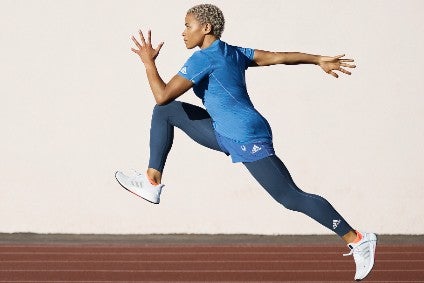
Adidas says it saw a strong sequential sales improvement in the third quarter thanks to a recovery in its business but has offered a cautious outlook for the remainder of the year as lockdowns continue in many of its major markets.
The German sporting goods firm saw revenues drop 7% to EUR5.96bn (US$7.06bn) in the three months ended 30 September. This compared to revenues of EUR3.58bn in the prior quarter.
Despite the consistently high store opening rate, exceptional growth in the company’s e-commerce channel continued at a currency-neutral rate of 51%. This growth was accompanied by a strong increase in full-price sales. The company’s overall direct-to-consumer business grew 13% in currency neutral terms and accounted for 35% of total sales in the quarter.
All market segments showed recovery compared to the second quarter, but on a year-on-year basis, only Europe recorded growth, of 3.3% to EUR1.75bn. Asia Pacific sales were down 10.4% to EUR1.87bn, North America’s were down 5.4% to EUR1.39bn, and Latin America slumped 26.9% to EUR296m.
Adidas recorded net income from continuing operations of EUR578m. This was down from EUR644m last year. The company’s gross margin decreased 2.1 percentage points to 50%. The growth of the direct-to-consumer business was offset by negative currency developments and promotional activity.
“We saw a strong recovery in our business in Q3,” said Adidas CEO Kasper Rorsted. “Our focus on healthy inventories, profitable sell-through and disciplined sell-in clearly paid off: inventories declined by more than half a billion Euros and our full-price share in e-com increased at a double-digit rate. At the same time, we kept costs under control and delivered a profit improvement of more than EUR1.1bn compared to Q2. As the coronavirus pandemic is unfortunately far from being over, it remains our top priority to keep everyone healthy and safe.”
The company says uncertainties around the pandemic and the macroeconomic environment remain high in the fourth quarter. The number of coronavirus cases in several of Adidas’ major markets has been on the rise recently, leading to new lockdown measures in several countries, resulting in the company’s global store opening rate falling to 93% most recently.
As a result, the company’s top line is predicted to develop similarly in the fourth quarter as it did in the third, implying a low- to mid-single-digit currency-neutral revenue decline. Gross margin is expected to be around the prior-year level, and operating profit at between EUR100m and EUR200m.
“While at the beginning of the quarter we were on track for growth in Q4, a worsening of the pandemic in many regions of the world is again requiring our patience and support,” added Rorsted. “However, this is not taking us by surprise. Thanks to our prudent approach, we are now well-prepared to cope with these short-term uncertainties. At the same time, we are even better positioned to benefit from the long-term industry growth drivers accelerated by the pandemic such as health and well-being, athleisure and digitisation.”
Driving growth
Sofie Willmott, content head of apparel at GlobalData, believes Adidas will be better protected than other apparel retailers with its reputation for high-quality sports-inspired casualwear and technical sports clothing making its products desirable in the long term.
“Additionally, its digital channels have proved to be robust driving strong growth throughout the pandemic so it can have confidence that shoppers will buy online with stores potentially not being accessible.
“Sportswear players have outperformed the apparel market in 2020 with Adidas’ close competitor Nike reporting sales down just 1% for its Q1 FY2020/21 (to the end of August) and Under Armour boasting flat sales for the same period as Adidas’ Q3. The long-term effects of the pandemic will be even greater consumer focus on health, wellbeing and fitness as well as a continued shift towards casual clothing impacted by the rise in working from home. As a result, sports brands will continue to outpace growth in clothing & footwear over the next few years and Adidas would be wise to hold on to Reebok, which it is reportedly considering selling, to get a higher price for it, or to benefit from better performance, later in 2021.”



